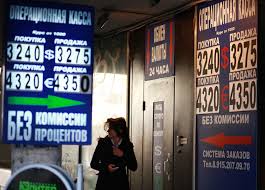In late November 2013, Finance Minister Anton Siluanov declared that the recent weakening of the ruble is nothing but a “ripple”. At the time, the ruble was trading at 33 per U.S. dollar, whereas in the last five years it had been trading stably within a range of 28-32 per dollar, except in 2009 when the ruble reached a low of 36 per dollar during the Russian financial crisis. In a year since November 2013, not only has the “ripple” not subsided, but it has actually begun to look like a storm – today, on November 10, 2014, the ruble is trading at 45 to the dollar. During September alone, the ruble’s exchange rate against the U.S. dollar has fallen almost 6 percent, and more than 20 percent since the beginning of this year (3 and 11 percent against the euro, respectively) Expert opinions on the ruble’s prospects vary. One thing is clear: fall’s reality turned out to be worse than last year’s most pessimistic forecasts.
At the same time, the Russian authorities do not have a unified position with regard to whether the ruble exchange rate should be fixed or stay floating. Thus, Russia’s Central Bank, fully supported by state banks, intends to shift to a free floating exchange rate regime by 2015, whereas presidential advisor Sergei Glazyev called for fixing the ruble’s exchange rate and keeping it that way for a few years. According to Sberbank analysts, the implementation of such scenarios as the fixing of the ruble exchange rate would spark a deposit run-off, speed up inflation and cause an economic decline. The population does not need explaining what a “free floating rate” will lead to. Having learned from the painful experience of the Russian crisis of August 1998, when as a result of the government’s irresponsible steps the value of the ruble had fallen threefold over the period of six months, Russians began to transfer their savings into hard currency in the spring of 2014.
Judging by the Central Bank’s recent activity (including a considerable rise in the interest rate aimed at making the ruble more attractive, and multi-billion interventions to slow its slide), bankers are forced to give in to the Kremlin’s pressure and to put the ruble’s free float off until things are better. The reason behind the government’s attempts at controlling the exchange rate is clear: oil price that is the main source of Russian budget revenue keeps falling, imports of goods are decreasing along with collected customs charges and duties, foreign countries are not willing to lend Russia money, while budget spending is rising. There are two ways to finance budget expenditures. The first option is to use the “money-printing machine,” which would speed up inflation that has already surpassed the forecasts. The second option consists of completely non-market measures such as the fixing of the ruble’s exchange rate, as suggested by Glazyev. It seems that the Russian authorities’ current tactic consists in upholding the status quo and refraining from sudden moves in order to avoid public anger over the collapse of the ruble.
In a country where the exchange rates of the national currency to dollar and euro are announced by banks’ ads on every street corner, no matter how often the government talks about stability, “spiritual bonds,” and the supremacy of the Russian idea, the regime’s fear of a “currency revolt” will always be stronger than the wish to have a normal market economy.






